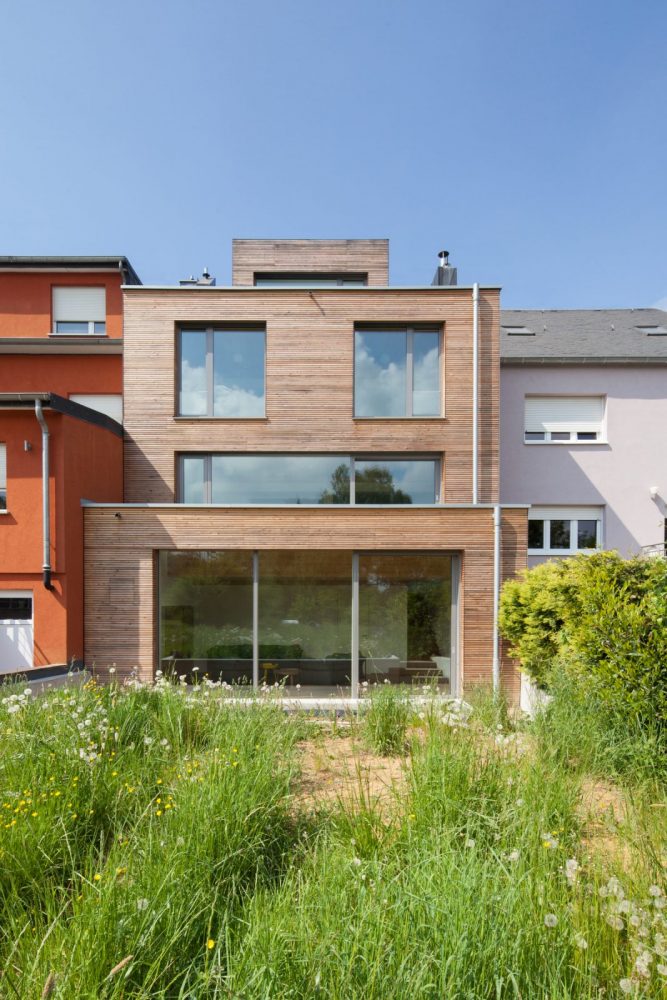Pilot project for positive energy in existing buildings
The aim of the project is to demonstrate the feasibility of converting and upgrading a 1950s terraced house into a positive energy house.
The general condition of the existing house was quite outdated. The exterior walls and roof were not insulated. The windows were only single glazed and had uninsulated roller shutter boxes. The attic had not been developed and there were numerous thermal bridges.
The existing house was completely renovated and energetically refurbished. The interior was reorganised and adapted to the new needs. In addition, the attic was converted and a three-storey extension was built at the back of the house. The additional volume enabled the bedrooms to be enlarged and a spacious kitchen on the ground floor and a generous living room on the garden level to be created. The new extension was built using prefabricated timber construction, a method of construction that greatly facilitated and accelerated the building process. Wood is a renewable material and its grey energy is considered very low. Wood also has very positive effects on indoor air, as it can regulate humidity. Its insulating value and positive static behaviour also make it possible to reduce the overall thickness of the exterior walls.
The energy concept is based on five different poles:
- Optimisation of the outer envelope :
The external envelope is considered the most important factor for energy saving, both during construction and renovation. The aim is to keep the heat losses of the envelope as low as possible and thus reduce energy consumption. - Optimisation of the technical installations:
A pellet boiler was installed because the CO2 balance is very good, the primary energy value is low, the hot water production is efficient and fast for 6 people and the price for installation is reasonable. Mechanical ventilation with heat recovery was also installed. - Reduction of internal demand:
To minimise energy consumption, the installed household appliances were of the A++ energy class type. However, it is also necessary to appeal to users to adopt good habits to reduce energy consumption, such as turning off the lights when leaving a room, turning off electrical appliances altogether, limiting water consumption, etc. - Energy generation:
Installation of 43 photovoltaic panels generating 13,917 kWh/year. - Reduction of grey energy:
The selection of new materials to be used took into account their grey energy.
- Optimisation of the outer envelope :
.
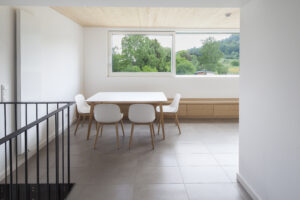
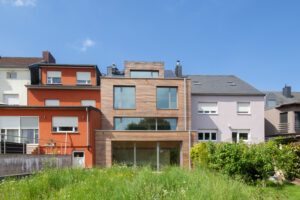
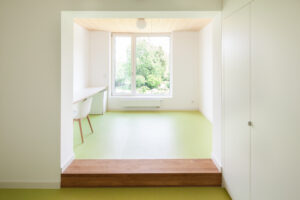
Conclusion:..
Achieving the level of a plus-energy house in an existing building is not an impossibility. Such a goal in the context of a renovation does mean conversion work and rather high investments, but the advantages are manifold. Compared to a new building, renovation has the advantage of benefiting from an existing building fabric whose grey energy is considered zero. A plus-energy renovation is therefore no more complicated than such a new building, but the approach is different. Compared to a new building, the possibilities for intervention are sometimes limited. However, one has to look at each project on a case-by-case basis, carry out a tailor-made architectural and energy analysis in advance, identify the needs in order to determine the possibilities and analyse the necessary and reasonable investments. Even if some compromises have to be made, the overall quality of the renovated building is quite comparable to a new building. The construction of low-energy and passive houses is currently the norm. However, it is becoming apparent that the energy renovation of old buildings also offers enormous potential for energy savings. The state has a duty to act in an exemplary manner with regard to energy consumption. However, this does not mean that everyone has to push renovation to this level of performance. Partial renovations or lighter renovations will bring a non-negligible reduction in energy consumption.
Address:.
55, rue des Fleurs (Blumenstraße)
L-3380 Schifflange
Those involved in the project..
Programme design :
In collaboration with the Maisons d’enfants de l’Etat.
Client:
Ministry of Sustainable Development and Infrastructures.
Administration for Public Buildings
Client :
Architect: Nicklas Architectes s.à r.l.
Civil engineer: MyCon Ingénieur s.à r.l.
Engineer for technical engineering: Bétic Ingénieurs-Conseils S.A.
Programme:
- 6 bedrooms
- 3 bathrooms
- Separate WC
- Common kitchen
- Office
- Garage for a small car
- Corner for bicycles
- Laundry room
- Storage room
Areas / Volume :
Gross area: 390 m².
Gross volume: 1,120 m³.
Land area : 9 Ar
Total costs :
EUR 1.1 million incl. taxes
ARR from 17.9.2015
Key dates of the project :
Beginn der Studien: Januar 2015
Beginn der Bauarbeiten: Juli 2016
Ende der Bauarbeiten: Februar 2018
Inbetriebnahme: April 2018
